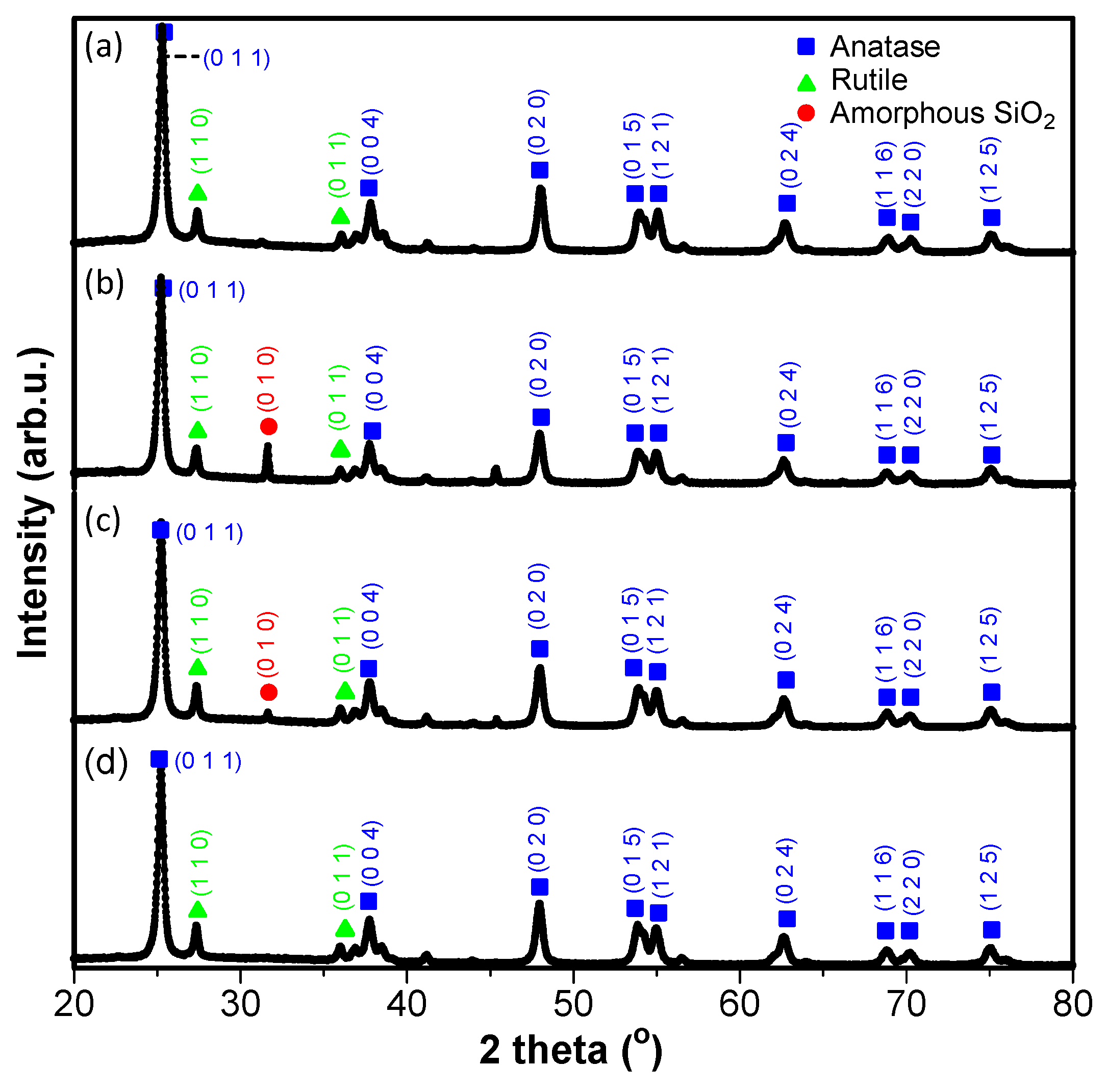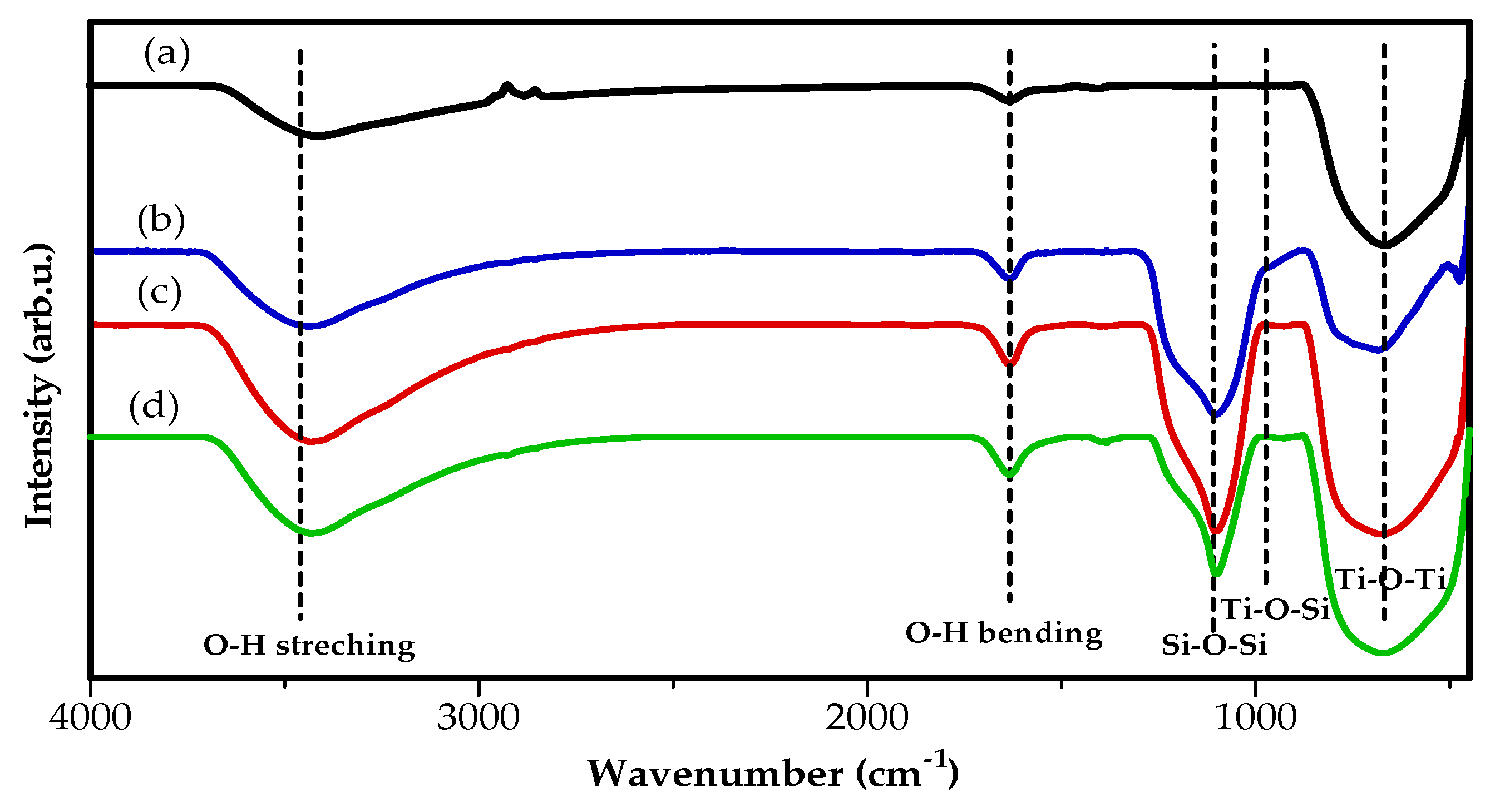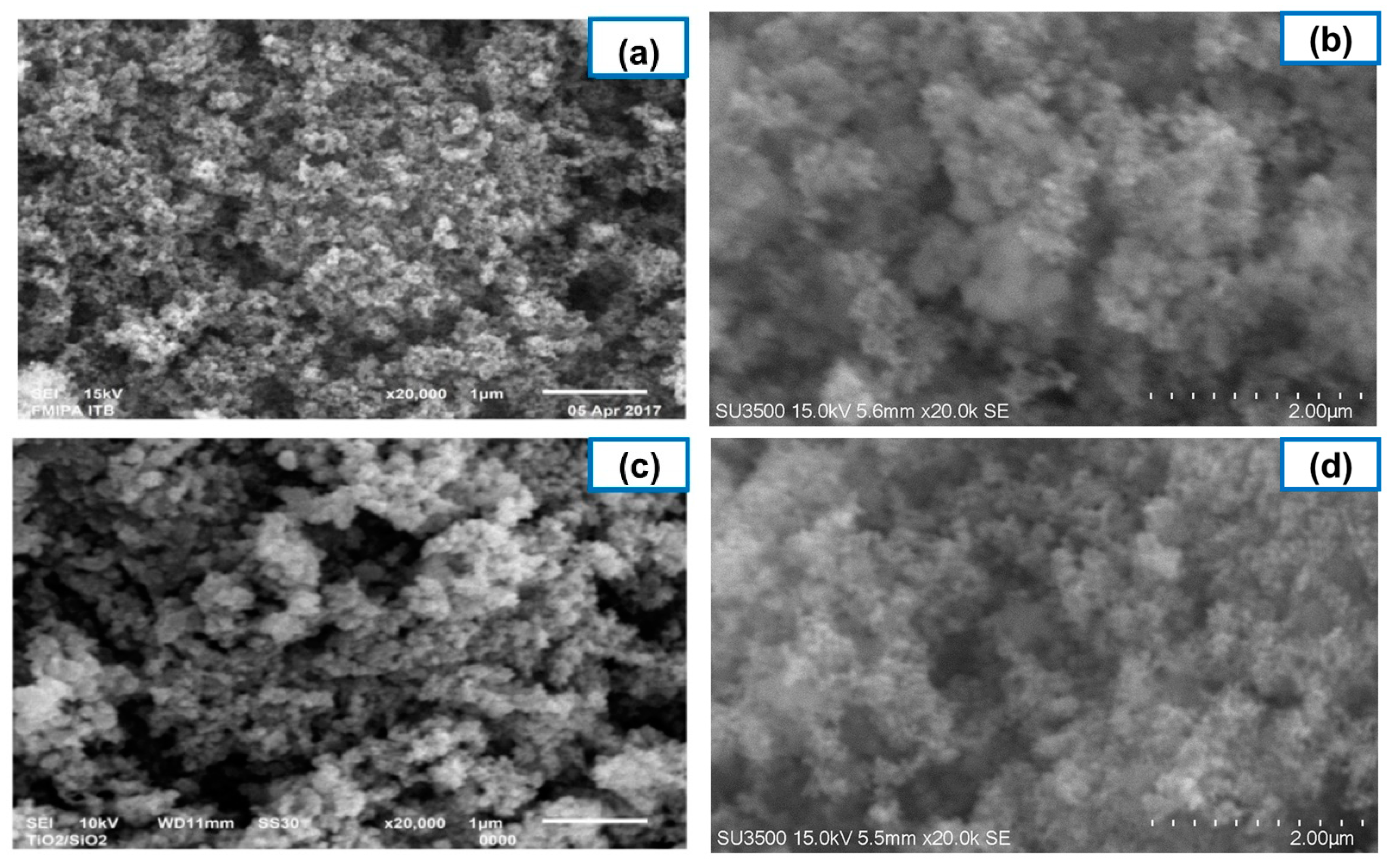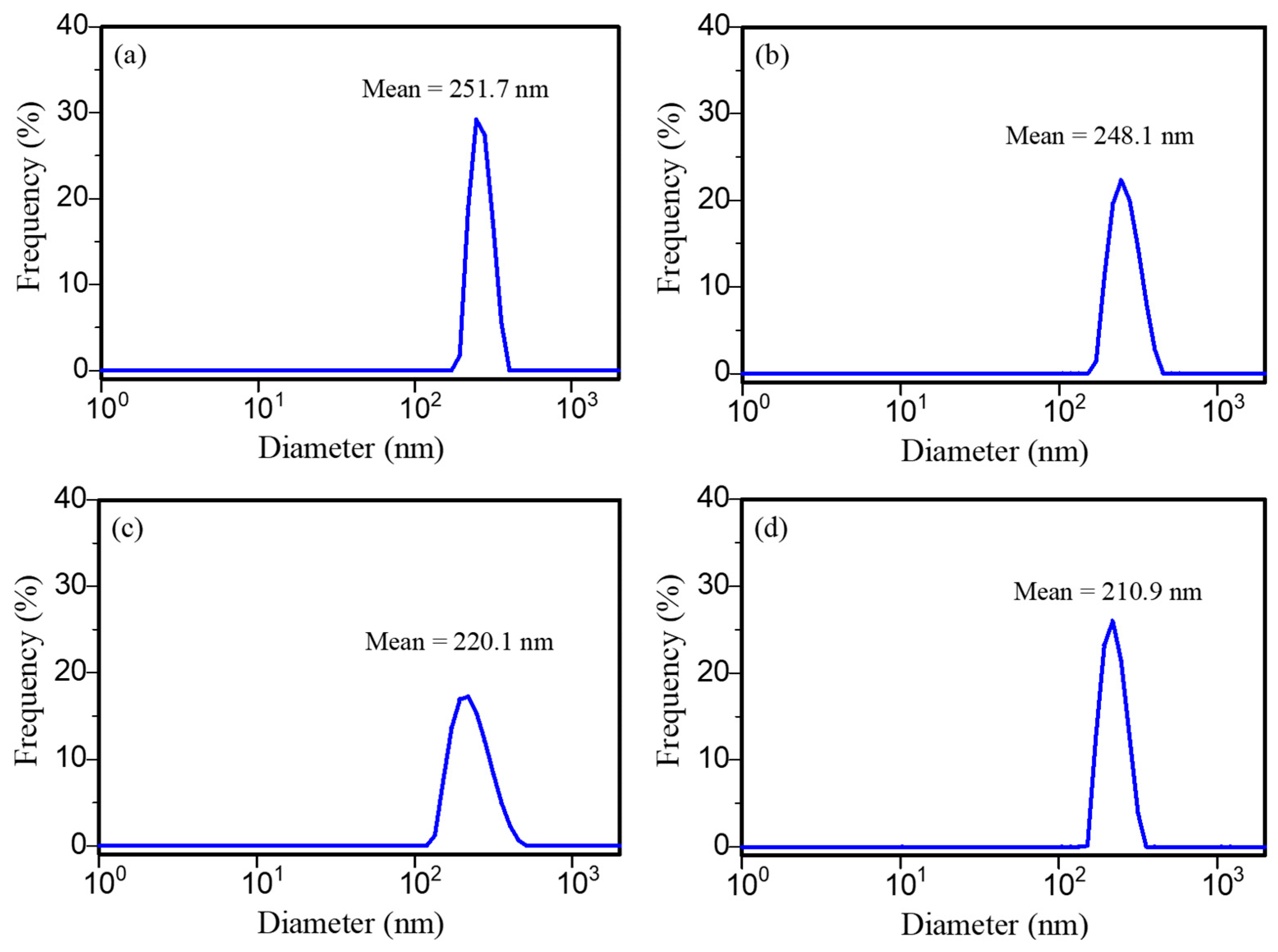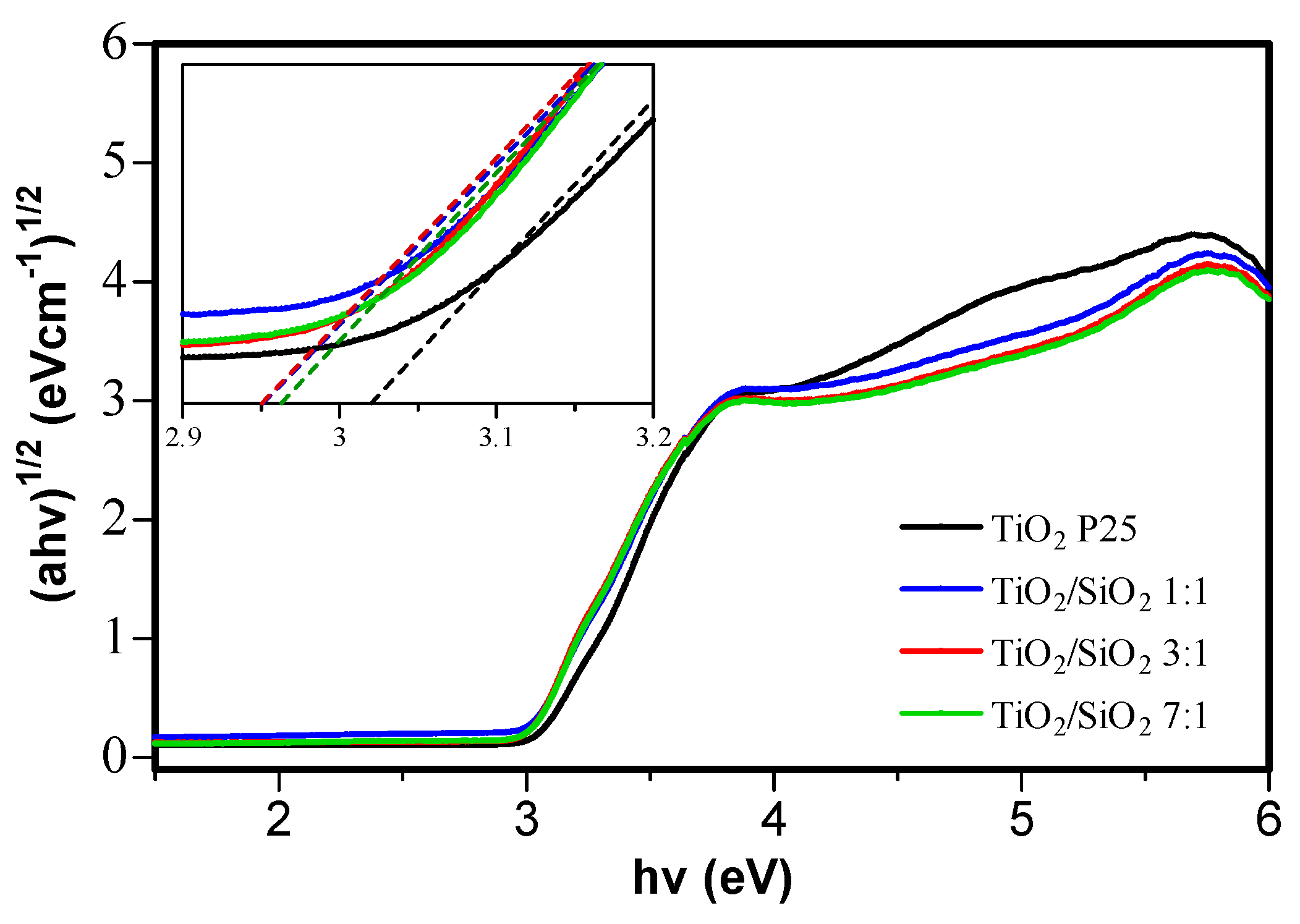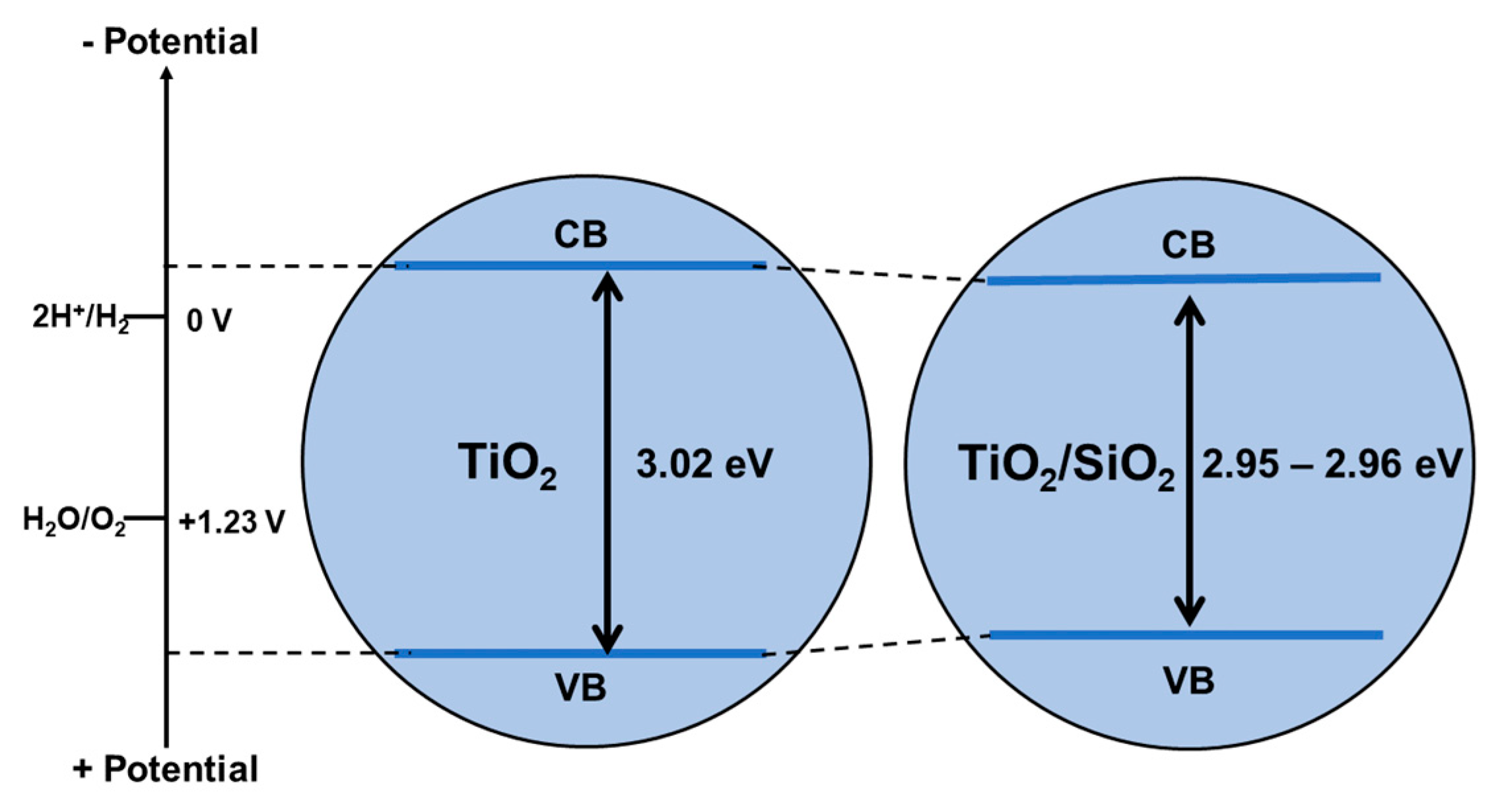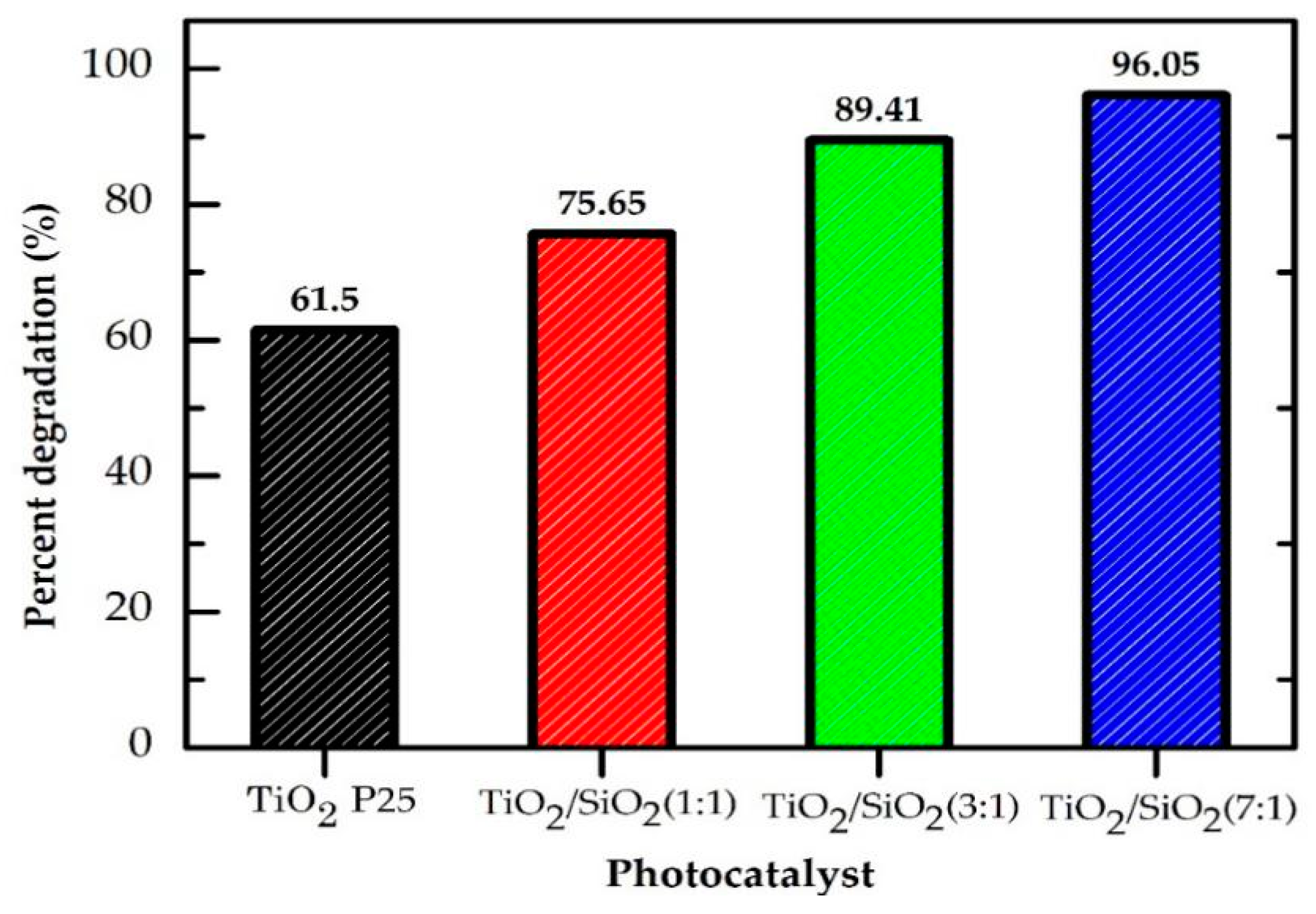3.1. Characterization of Catalyst TiO2/SiO2 Composite Structure
The structure and phase of the TiO
2 and TiO
2/SiO
2 composites was observed from the diffraction patterns shown in
Figure 1. These patterns showed the diffraction patterns of TiO
2 P25 Degussa and composites of TiO
2/SiO
2. The standard atomic parameters of anatase TiO
2 (tetragonal, space group
I4
1/
amd) were taken from the Inorganic Crystal Structure Database (ICSD) 98-004-4882 [
27] and ICSD 98-008-2085 for rutile structures (tetragonal, space group
P4
2/
mnm) [
28]. The crystal of the TiO
2 P25 Degussa showed the highest peak pattern at 2θ = 25.25° and several other distinctive peaks, specifically at 2θ = 37.80° and 47.89° and twin peaks at 53.90° and 55.91°, which are regions of anatase type TiO
2 crystal characteristics. All TiO
2/SiO
2 composite diffractograms showed very similar peaks, the difference being the intensity and widening at certain peaks.
Figure 1 shows that the composite composition affected the peak intensity and the sharpness of the resulting peak and that a large amount of SiO
2 caused a decrease in peak intensity and a band widening leading to reduced crystallinity (
Table 1). These results are confirmed from a previous study reported by Pinho and Mosquera [
29]. Another reason for the reduced peak intensity is that possibly the inter lattice between Ti, O, and Si was formed during the synthesis process [
30]. This result can be seen with the appearance of a new peak at 2θ = 31.68°. The FTIR technique was used to confirm the presence of these Ti–O–Si bonds, which will be discussed later.
Phase percentages showed in
Table 1 were obtained using Rietveld refinement (
Figures S1–S4) of the XRD patterns in the composite showing the percentages of anatase and rutile phase. From the data in
Table 1, it is observed that TiO
2/SiO
2 1:1 has the highest anatase phase followed by TiO
2/SiO
2 3:1 and TiO
2/SiO
2 7:1. The composite of TiO
2/SiO
2 1:1 has the smallest rutile percentage; this indicates that the presence of SiO
2 will inhibit the formation of the rutile phase from anatase [
14,
31].
Furthermore, materials with an amorphous phase showed a wide band when analyzed using XRD due to the irregular arrangement; that is, this material was rigid and does not have a certain geometric shape. SiO
2 with its surface amorphous phase had more defects that interacted with the contaminants; meanwhile in the crystalline SiO
2, the structure was regular and the bond was more stable, which made it less capable of adsorption and easier desorption [
25]. In addition, the amorphous SiO
2 structure affected the TiO
2 structure in the composite, which resulted in a decrease in intensity and a widening at the peak, indicating that the crystallinity of TiO
2 decreased. The TiO
2/SiO
2 1:1 composite showed the lowest crystallinity value due to the effect of the most addition of SiO
2, while TiO
2/SiO
2 7:1 had the higher crystallinity (
Table 2). High crystallinity promoted a charge transfer from the center to the surface of the photocatalyst, which increased the photocatalytic activity [
32].
The crystallite size is calculated based on the Scherrer equation. The calculated crystallite size is the average of each phase peak in the XRD pattern and is calculated with the standard deviation.
Table 2 shows that the presence of SiO
2 can reduce the crystallite size. The largest crystallite size was found in the TiO
2/SiO
2 7:1 composite with anatase 16.28 ± 2.30 and rutile 26.06 ± 2.52. The size of this crystallite decreases with the amount of SiO
2. It can be understood that the more SiO
2 is added, the more defects and the amorphous phase will increase [
29,
31,
33]. As a result, the crystallinity is getting smaller, which causes the peak of the XRD pattern to widen. With the widening of the XRD peak, the full width at half maximum (FWHM) value will be larger and the calculated crystal size will be smaller.
The sample unit cell parameters and Rietveld refinement parameters are reported in
Table 3. The Rietveld refinement plot is depicted in
Figures S1–S4. From the table, it is known that the presence of SiO
2 caused a slight change in the anatase and rutile unit cells. From this value, it can be seen that SiO
2 will enlarge the unit cell of anatase and rutile. This trend is clearly seen by the presence of the largest unit cell, namely, in the TiO
2/SiO
2 1:1 composite with an anatase volume of 136.4306 Å
3 and rutile volume of 62.4995 Å
3. This volume decreases as the amount of SiO
2 decreases, and the smallest is found in TiO
2 P25 without SiO
2 added.
The next characterization was Fourier-transform infrared spectroscopy (FTIR), used to identify the functional groups in the TiO
2/SiO
2 composites at wave number 450–4000 cm
−1. The resulting spectrum in
Figure 2 shows that the characteristics of the IR absorption band at wave number 3410–3435 cm
−1 was a stretching vibration of –OH, while at 1633–1636 cm
−1, it was a typical absorption for the bending vibration of –OH [
25]. The strong and dominant absorption peak discovered at wave number 1101–1103 cm
−1 was the asymmetric stretching vibration of the Si–O–Si (siloxane) bond [
25]. Furthermore, the absorption peak appearing at the wave number 475.0 cm
−1 was caused by the vibration of the O–Si–O (siloxy) bond stretching. Meanwhile, the peaks discovered at 667–686 cm
−1 showed the vibration of the Ti–O–Ti bond stretching [
34]. The presence of a Ti–O–Si vibration peak in the wavenumber region of 920–960 cm
−1 [
35] at a TiO
2/SiO
2 1:1 ratio indicates that the interaction between TiO
2 and SiO
2 is a chemical reaction process (a chemical bond occurs) rather than a simple physical mixing process. Although this peak was not detected at TiO
2/SiO
2 3:1 and 7:1. The wavenumber data of the IR spectrum in
Figure 2 is presented in
Table 4. The O–H stretching and bending vibrations observed in the spectra of all the composites are characteristic of SiO
2 and TiO
2 P25, and indicate successful synthesis. These peaks increase in intensity, with a rise in SiO
2 content due to the high surface water adsorption [
35], while the difference in O–H intensity between the two compounds shows SiO
2 possesses an active O–H side for surface reaction.
3.4. Characterization of Particle Size Distribution of TiO2/SiO2 Composites
The particle size distribution of TiO
2 P25 and TiO
2/SiO
2 composites were analyzed using a particle size analyzer (PSA). The data presented in
Figure 4 show that the particles were homogeneous, which is indicated by only one peak on the histogram of each sample. Data regarding the mode values, mean, median, z-average, and polydispersity index (PI) are shown in
Table 6.
From the data in
Table 6, it was observed that the addition of SiO
2 to a composite in the right composition caused the z-average or the average size of the particles to become smaller. In addition, the most occurring particle size was observed from the mode value. The mode value of each composite variations 1:1, 3:1, and 7:1 is 232.6, 204.5, and 204.8 nm, respectively. Meanwhile, the mode value of TiO
2 P25 was 236.6 nm and the mean particle size value for the TiO
2 and TiO
2/SiO
2 composite variations 1:1, 3:1, and 7:1 is 288.2, 322.8, 320.2, and 223.4 nm, respectively.
The polydispersity index (PI) value is a measurement of the molecular mass distribution in the sample. It is expressed as the weight average molecular weight divided by the number average molecular weight. Results from the study carried out by Danhier et al. [
37] (in Yeni et al. [
38]) states that if the PI value is less than 0.3, it indicates that the sample has a narrower distribution of nanoparticles and the size of the nanoparticle diameter is uniform or homogeneous. However, it was very difficult to make particles of a uniform size (monodispersion), and although monodispersion of particle size was obtained, it was actually a polydispersion particle with a very narrow particle size distribution. From
Table 6, it was observed that the PI value for the TiO
2/SiO
2 composites variations 1:1, 3:1, and 7:1 is 0.434, 0.387, and 0.353, respectively. Furthermore, the PI values of these samples fell into the mean range of the polydispersity index 0.3–0.7, where the distribution operated best. From the average particle size data and PI in
Table 6, it was observed that the TiO
2/SiO
2 7:1 variation had the smallest average particle size and the highest homogeneity. It can be understood that the amount of SiO
2 affects the sample size, in that a small amount of SiO
2 added can cause a decrease in the particle size. However, a large amount of SiO
2 will cause an increase in the agglomeration and therefore increase the particle size.
Therefore, compositing TiO
2 and SiO
2 led to a relatively small particle size and even distribution in TiO
2 [
39] in TiO
2/SiO
2 7:1. The reduction in size lessened the formation time and increased the redox rate for electrons and holes during the surface photocatalytic process. This also lowered the photoelectron and hole recombination; hence, the catalyst’s performance was improved [
15].
3.5. Bandgap Characterization of TiO2/SiO2 Composites
UV-vis analysis on the catalyst was used to determine the bandgap of the photocatalyst. TiO
2 P25 Degussa has clear ultraviolet light absorption characteristics. Although not significant, there was a decrease in the bandgap for the synthesized composites compared to TiO
2 P25 Degussa, indicating that SiO
2 gave a slight change to the electronic state of TiO
2. The optical bandgap energy (Eg) is obtained using the Tauc equation [
40]:
where α is the absorption coefficient,
hν is the energy of the photons, and A denotes the proportionality constant. The transition property is represented by n, where n = 1/2 for the indirect bandgap allowed [
40]. Bandgap energy is calculated by plotting (α
hν)
1/2 vs.
hν (
Figure 5). The bandgap values of TiO
2 P25 Degussa and TiO
2/SiO
2 composites are shown in
Table 7. TiO
2 P25 Degussa has a bandgap value of 3.02 eV, where the TiO
2/SiO
2 composites have a smaller bandgap, namely, 2.95 eV for TiO
2/SiO2 1:1 and 2.96 eV for TiO
2/SiO
2 3:1 and 7:1.
The difference in bandgap values can be explained in terms of changes in the energy of the TiO
2 bandgap due to SiO
2. The cause of this bandgap difference is possible through three mechanisms: (i) quantum size effect [
33]; (ii) Ti–O–Si bond formation, leading to electronic structure modification [
30]; and (iii) percentage difference between the anatase and rutile phases, where rutile has a different bandgap with anatase [
41].
Figure 6 shows the energy band diagram of the TiO
2 and SiO
2/TiO
2 composites. Due to the very large SiO
2 bandgap (8.6 eV) [
42], electron heterojunction between the valence band and conduction band of TiO
2 and SiO
2 is difficult. Bandgap changes only occur due to Ti–O–Si bond formation.
3.6. Photocatalytic Activity Test of TiO2/SiO2 Composites on Phenol
Various previous studies have reported composites between TiO
2 and SiO
2. Several sources of SiO
2 are reported from various sources, such as extraction from natural materials and commercial SiO
2. Examples of studies using TiO
2 and SiO
2 composites from various sources are presented in
Table 8. The SiO
2 used in this study was extracted from Bengkulu beach sand, Indonesia (extracted by Ishmah et al. [
24]). Research on TiO
2/SiO
2 composites with SiO
2 as a source of sand is still rarely reported.
The activity of the TiO
2/SiO
2 composite photocatalysts was tested against the decrease in phenol concentrations to determine the performance of the synthesized photocatalysts compared to TiO
2 P25 Degussa. Phenol was chosen as a media for photocatalyst application because it is a toxic organic compound found in industrial waste in rivers and streams [
4,
45]. This test was performed using a simulated sample of phenol standard solution that was analyzed using high-performance liquid chromatography. The results of the phenol photocatalytic test are shown in
Figure 7.
From
Figure 7, it was observed that the decrease in concentration until the 60th min was the effect of adsorption from the photocatalyst since the test was carried out without UV light irradiation until the 60th min. Furthermore, tests with UV light irradiation were carried out at 60 to 180 min, where a significant decrease in concentration was observed after activation of the photocatalyst by light. The TiO
2 photocatalyst added with SiO
2 resulted in a decrease in the phenol concentration, which was observed on a more descending curve.
In the adsorption process until the 60 min, it was observed in the curve that TiO
2 had adsorption ability; however, the resulting decrease in concentration was lower. Meanwhile, when added with SiO
2, the adsorption ability increased significantly. The addition of SiO
2 to the TiO
2 photocatalyst was directly proportional to the percentage of phenol adsorption. The percentage of phenol reduction during the adsorption process (without UV light irradiation) using TiO
2 P25, for TiO
2/SiO
2 composites with the variations 7:1, 3:1, and 1:1, is 4.60, 16.11, 19.45, and 21.48%, respectively. Data of the phenol concentration and percentage reduction at any time are presented in
Table 9.
The photocatalysts exhibited a higher percentage reduction under exposure to UV light. This indicated the performance in phenol oxidation is influenced by photons from UV light. In photocatalysts exposed to UV light, photo-oxidation is commenced by absorbing photons of a higher energy than the photocatalyst’s bandgap. This results in an electron jump from the valence (e
cb) to the conduction band (h
vb). Consequently, holes and electrons are formed in the h
vb and e
cb, respectively. These react with oxygen (O
2) and water (H
2O) from the environment, provided by the photocatalyst, respectively, to produce •OH radicals. The •OH radicals formed reacted with the metal and the phenol degradation process occurred [
46,
47,
48]. Meanwhile, for unexposed photocatalysts to UV light (dark state), there were no photons (UV light) to activate the photocatalyst’s performance; therefore, there was no photo-oxidation reaction. The process of the decrease in the phenol concentration was the adsorption process from the catalyst that became larger in capacity due to the large silica content in the photocatalyst, considering that silica is a good adsorbent with a large adsorption capacity [
15].
From
Table 9, it was observed that the addition of SiO
2 increased the percentage of phenol degradation. SiO
2 substrate was an adsorbent that provided an adsorption side to support TiO
2 through the adsorption process; therefore, more pollutants were degraded [
49]. The efficiency of the phenol concentration reduction is seen in
Figure 7. After testing for 180 min, it was observed that the TiO
2 P25 Degussa photocatalyst had a phenol reduction percentage of 61.5%, while the percentage of phenol reduction for the TiO
2/SiO
2 composites with the variations of 1:1, 3:1, and 7:1 were 75.65, 89.41, and 96.05%, respectively. Furthermore, the highest percentage of phenol reduction was shown by the photocatalyst of the TiO
2/SiO
2 composites with the 7:1 variation. This occurred because this variation had the smallest and most homogeneous particle size among the samples; therefore, this photocatalyst provided a larger surface area, which improved its performance in decreasing the phenol concentration. The efficiency of reducing the phenol concentration is seen in
Figure 8.
The kinetics of the photocatalysis was observed using the Langmuir–Hinshelwood first-order and second-order kinetic model. The first-order kinetics was calculated using [
50]:
where C represents the concentration of phenol (mg.L
−1) and
k1 denotes the first-order rate constant (min
−1). Meanwhile, at the start of the reaction, t = 0 and Ct = Ci. Therefore, the equation below is obtained after integration:
where, Ci signifies the initial concentration of phenol in mg.L
−1, Ct represents the concentration (mg.L
−1) of phenol in the solution at t min, b denotes a constant, and
k1 (min
−1) is the first-order rate constant.
Table 10 shows the increase in reaction kinetic constant due to the addition of SiO
2. The highest
k value is found in the TiO
2/SiO
2 composite ratio of 7:1, namely, with a
k1 of 0.0267 min
−1, followed by the composite ratio 3:1 and the composite ratio 1:1. The results show that phenol removal efficiency of the TiO
2/SiO
2 composite with the 7:1 ratio was 3.5 times higher compared to TiO
2 P25, indicating that SiO
2 promoted the photocatalytic ability significantly on TiO
2.
The catalytic activity in the photodegradation of phenol is compared with the data that have been reported in the literature shown in
Table 11, clearly showing that our data on photoactivity are compared with those published in the literature.
